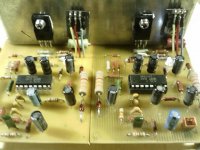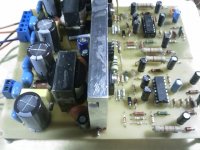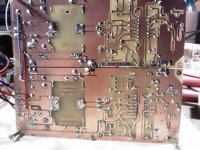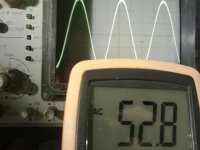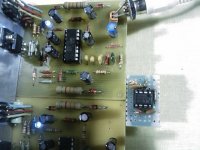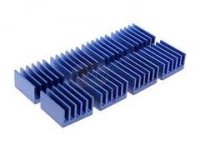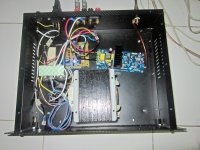Hi Rens,
Clear, will use a "star" for V+ / V- too.
Once ready I will post a picture ;-)
Thanks
Peter
Hi Peter,
I built my amp with a wiring quite similar to your sketch. I showed some pictures of it in the pictures-thread.
http://www.diyaudio.com/forums/class-d/87913-class-d-amp-photo-gallery-60.html#post3310563
I have no hum and no problem with ground loops.
Yesterday, I build a test setup with A1000SMPS and 2x L-15D-PRO (see Class D Amp Photo Gallery post 606, connected to a miniDSP 4x10 HD. All is working fine, sound is good, but bass is lacking a lot. My old UcD400, and even cheap *** T-amp had a much fuller bass.
It might be the DC blocking cap, but I guess that only part of the story. Could it be that the miniDSP is not comfortable driving the low imput impedance of the amp? If so, I'll try adding a unity gain buffer in front of the amp to improve things. Are there any other people that noticed this?
It might be the DC blocking cap, but I guess that only part of the story. Could it be that the miniDSP is not comfortable driving the low imput impedance of the amp? If so, I'll try adding a unity gain buffer in front of the amp to improve things. Are there any other people that noticed this?
Yesterday, I build a test setup with A1000SMPS and 2x L-15D-PRO (see Class D Amp Photo Gallery post 606, connected to a miniDSP 4x10 HD. All is working fine, sound is good, but bass is lacking a lot. My old UcD400, and even cheap *** T-amp had a much fuller bass.
It might be the DC blocking cap, but I guess that only part of the story. Could it be that the miniDSP is not comfortable driving the low imput impedance of the amp? If so, I'll try adding a unity gain buffer in front of the amp to improve things. Are there any other people that noticed this?
Hi 4Real
Must be your miniDSP not liking the L15D , the input cap of 22 micro's has an impedance of 390 ohms at 20 Hz , that gives a - 1 dB at 20 Hz with the 3k23 input impedance ( Unsuitable for "Passive" Preamplifiers post #390) of the amp . My system improved slightly in the Bass region after I added two 12000 uF buffer caps on the A1000SMPS.But even before that Bass was very good .
Cheers ,
Rens
Last edited:
Thought so. I'll try connecting my iPad and see if that works better bass wize. If it can drive a headphone, is can surely drive the amp. If so, I'll be adding a LM4562 buffer with unity gain in front of the amps, giving in 100k input impedance. I have aux power on my PSU, so this sould be an easy fix. I just hope that it will all still fit in the case I have in mind.
About the extra buffer caps. That also crossed my mind. The A1000SMPS only has 10.000uF. I read somewhere that adding a lot more might destabalize the SMPS because it is tuned to the capacitance. I'll ask Cristy about it.
About the extra buffer caps. That also crossed my mind. The A1000SMPS only has 10.000uF. I read somewhere that adding a lot more might destabalize the SMPS because it is tuned to the capacitance. I'll ask Cristy about it.
D
Deleted member 148505
Good remark Jan ,
You made me thinking , I have no audible problems with this and read allot about it . So I measured my carrier frequencies today and they are well within 25 kHz of each other . LF and RF are just 4 kHz apart and the rest of the channels within 10 kHz . If I use the amp in Stereo mode ( 2 channel RF and LF ) the sound stage is very precise and dolby digital is just stunning , enjoy it every day .
What I understand from the papers is that the THD is about 10 times higher at low power and the AM intermodulation and EMI are much higher if you synchronise the clocks . I have noticed that the new CxD250-HP from Christi at Connexelectronic has the ability to synchronise the clocks , so lets have some discussion here
It's quite easy to ad an external clock to my 5 L15D's just 5 resistors and 5 capacitors and a clock . Does it make sense ???
Cheers ,
Rens
And I'm drinking a nice Chardonnay
Hi,
I think the hassle of putting an external module to synchronize the clock is not worth for the small improvement on distortion.
D
Deleted member 148505
I am currently using this one as a subwoofer amp for my 4 ohms JBL GT5-12, because my IRS900 died after I accidentally shorted the output while there's an input signal. I connected it to the sub pre-out of my receiver, it has good and detailed bass but lean and not so powerful, also cone movement is kinda loose. Unlike my the previous IRS900 that makes my subwoofer sounded like an 18 incher, bass is much fuller and the cone movement is well controlled. ( both are using the same power supply ). There must be some cause why the L25d is not delivering full sounding bass.
I also noticed that the inductor is hot even when the amp is idle, I think it needs ram heatsink like the one attached.
Also when I tested it on full range, sound of the highs is a bit dry and sibilant compared to my other class ab amps, does anyone noticed this too?
I'll increase the self osc frequency to 450khz to check if the highs will improve.
I also noticed that the inductor is hot even when the amp is idle, I think it needs ram heatsink like the one attached.
Also when I tested it on full range, sound of the highs is a bit dry and sibilant compared to my other class ab amps, does anyone noticed this too?
I'll increase the self osc frequency to 450khz to check if the highs will improve.
Attachments
Last edited by a moderator:
I just tested my ipad with the l15d-pro. Bass is just fine. Looks like the minidsp is indeed the probel here. It just can't drive the low imedance of the amp. So now I have two options:
- make a buffer
- replace the opamps of the minDSP for one that can drive lower loads, for example LM4562
- make a buffer
- replace the opamps of the minDSP for one that can drive lower loads, for example LM4562
I also noticed that the inductor is hot even when the amp is idle, I think it needs ram heatsink like the one attached.
The ram heatsink might alter your inductor's ferromagnetic properties .
Cheers ,
Rens
D
Deleted member 148505
The ram heatsink might alter your inductor's ferromagnetic properties .
Cheers ,
Rens
I don't have an inductance meter right now so I can't check if it will change if I put a heatsink on top of it.
Your inductor shouldn't get hot, I have a 750 watt amp that runs slightly warm all the time.
Which core did you use ?
I use a t106-2.
It uses an inductor that looks like a Sagami 7G17A, but it has no label, that's why I am doubting if it is an original one.
I will also check if the inductor will run cooler if I raise the osc freq.
Attachments
It uses an inductor that looks like a Sagami 7G17A, but it has no label, that's why I am doubting if it is an original one.
.
Its probably the wrong core material.
My first class d inductor was a power toroid and it got to 120 degrees c !
Inductor
Anyone know where to get the inductor in Germany? Googleing for it results in pdf files for the IRS2092!!
I was thinking of replacing the indcutors on my L25D boards along with replacing the current protection resistors R12 and R18 to be in line with the AMP7S-150 values for my 4Ohm speakers, also the filter caps CP7, CP8 with Panasonic FC 100V 470uF value as in line with the iraudamp7s.pdf. R114, R117 and R118 will be changed to 3 Watts.
Big thanks to alkasar for his great work in the Mounting Guide L25D.doc
Also anyone know why the R24 and R25 are listed in the iraudamp7s.pdf as 20 Ohm and in the Application Note irs2092.pdf they are listed as 10 Ohm.
BTW: I have amazing sound and serious *** kicking bass with a Cambridge Audio Azur DacMagic (using RCA output - will change to XLR) and a 10K Pot from my L25D boards. I removed the input cap CP1 and bridged it with some resistor leg wire. This improved the sound a lot. I had originally planned to replace the input caps with WIMA MKP 22uF and purchased some, but my DAC has practically zero DC in its output and I also have DC protection boards as recommended in this thread.
Cheers
Anyone know where to get the inductor in Germany? Googleing for it results in pdf files for the IRS2092!!
I was thinking of replacing the indcutors on my L25D boards along with replacing the current protection resistors R12 and R18 to be in line with the AMP7S-150 values for my 4Ohm speakers, also the filter caps CP7, CP8 with Panasonic FC 100V 470uF value as in line with the iraudamp7s.pdf. R114, R117 and R118 will be changed to 3 Watts.
Big thanks to alkasar for his great work in the Mounting Guide L25D.doc
Also anyone know why the R24 and R25 are listed in the iraudamp7s.pdf as 20 Ohm and in the Application Note irs2092.pdf they are listed as 10 Ohm.
BTW: I have amazing sound and serious *** kicking bass with a Cambridge Audio Azur DacMagic (using RCA output - will change to XLR) and a 10K Pot from my L25D boards. I removed the input cap CP1 and bridged it with some resistor leg wire. This improved the sound a lot. I had originally planned to replace the input caps with WIMA MKP 22uF and purchased some, but my DAC has practically zero DC in its output and I also have DC protection boards as recommended in this thread.
Cheers
Just finished amp with L25D 's, stereo.... I use toroid 52vac per side to rectifier PCB with 68
of those 150 mfd 80v electrolytic caps... The transformer is 550va size.... Also I use a 30 amp speaker protection PCB... Using little NE5532a preamp module with Bass, Mid, Treble, Volume controls... Anyway my layout was nice and when I turned power on I was and am
Very Pleasantly surprised! It works so nice! I am very pleased. I did have to purchase some speakers that can handle the power, and they turned out to be very nice too! Anyway bottom line is the LJM L25D power amp module sounds like a million bucks! Start building your new power amp today! I'm going to start working on a preamp that get rid of the NE5532's in favor of discrete, however I want Gain, Bass, Treble, also a vacuum tube buffer along with hi filter and loudness switch! So much for purest! It is going to sound nice! This I know! -Joe
of those 150 mfd 80v electrolytic caps... The transformer is 550va size.... Also I use a 30 amp speaker protection PCB... Using little NE5532a preamp module with Bass, Mid, Treble, Volume controls... Anyway my layout was nice and when I turned power on I was and am
Very Pleasantly surprised! It works so nice! I am very pleased. I did have to purchase some speakers that can handle the power, and they turned out to be very nice too! Anyway bottom line is the LJM L25D power amp module sounds like a million bucks! Start building your new power amp today! I'm going to start working on a preamp that get rid of the NE5532's in favor of discrete, however I want Gain, Bass, Treble, also a vacuum tube buffer along with hi filter and loudness switch! So much for purest! It is going to sound nice! This I know! -Joe
Yesterday I put a unity buffer between miniDSP and L-15D-PRO, and now bass is just as is should be. Looks like the miniDSP just can't drive the amp directly. Well I'm happy now. Just need to make a few more buffers for all of the eight amps, or also try replacing the opamps if the miniDSP.
Interesting, a german bloke saarmichel has 4 L15Ds with a Mini DSP connected to a 4Ohm system with 2.8 Ohm in the Bass and reckons sounds very very good.
You can see the mini dsp on the back on the right.
Bild: minidsp-4k-ampfu7q.jpg - abload.de
You can see the mini dsp on the back on the right.
Bild: minidsp-4k-ampfu7q.jpg - abload.de
I'm wondering if anyone has seen this b4 or has any suggestions they can lend.
I connected the 2nd l15D-Pro board to share the same power supply as the 1st. Music plays from both channels at very low volume but as soon as I even slightly turn up the volume the 2nd board loses power until I turn the volume back down (Power LED goes out, music cuts out, almost as if the board's going into protection but the speaker protection doesn't engage). The 1st channel is operating as it should.
Has anybody seen this before?
Thanks
I connected the 2nd l15D-Pro board to share the same power supply as the 1st. Music plays from both channels at very low volume but as soon as I even slightly turn up the volume the 2nd board loses power until I turn the volume back down (Power LED goes out, music cuts out, almost as if the board's going into protection but the speaker protection doesn't engage). The 1st channel is operating as it should.
Has anybody seen this before?
Thanks
Hello.
I've built 6 of the L25D amplifiers now, and 2 L15D to power my surround system. I use them to bi-amp front an center, while the L15D's are connected to the surround speakers.
The "processor" is a Yamaha RX-A810, receiver with pre-out. Last time I ran YAPO, room correction, I got the message that all my speakers where miswired.
Therefor I tried to measure input/output with an oscilloscope, an learned that the L25D reverse the phase from input to output. Anyone else who has discovered this?
The "prove" is in the picture below, keep in mind that for test purposes I used a small transformer 2x30V/120VA. I normally use 2x45V/500VA for two amplifier connected to a Klipsch RF-82.
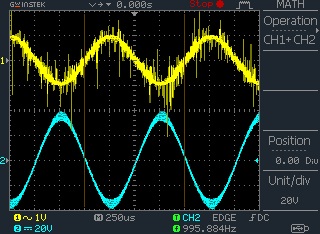
No problem to fix the bug, but I find it strange that I have not read about this before I discovered it myself.
I've built 6 of the L25D amplifiers now, and 2 L15D to power my surround system. I use them to bi-amp front an center, while the L15D's are connected to the surround speakers.
The "processor" is a Yamaha RX-A810, receiver with pre-out. Last time I ran YAPO, room correction, I got the message that all my speakers where miswired.
Therefor I tried to measure input/output with an oscilloscope, an learned that the L25D reverse the phase from input to output. Anyone else who has discovered this?
The "prove" is in the picture below, keep in mind that for test purposes I used a small transformer 2x30V/120VA. I normally use 2x45V/500VA for two amplifier connected to a Klipsch RF-82.

No problem to fix the bug, but I find it strange that I have not read about this before I discovered it myself.
- Home
- Amplifiers
- Class D
- My design L20D IRS2092+IRFI4020H 200W8R
